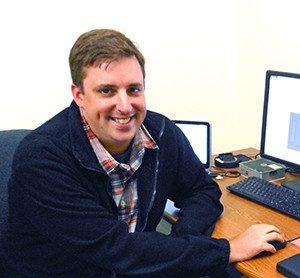 Andrew Zeitler is a senior in the Engineering Technology bachelor’s program at UH Maui College. He holds an Associate of Arts degree from Green River Community College, an Associate of Science in Electronic and Computer Engineering Technology (ECET) from UH Maui College, and an Associate of Applied Science in Electronic Systems Technology from the Community College of the Air Force. Andrew is working toward a career in optoelectronics, with the intention of working with the various observatories on Haleakala and Mauna Kea. He is a member of IEEE, and his interests include neuroscience, hiking, scuba diving, sailing, and volunteering for Read Aloud America. In his spare time, he enjoys traveling and has been to more than 30 countries across all seven continents
Andrew Zeitler is a senior in the Engineering Technology bachelor’s program at UH Maui College. He holds an Associate of Arts degree from Green River Community College, an Associate of Science in Electronic and Computer Engineering Technology (ECET) from UH Maui College, and an Associate of Applied Science in Electronic Systems Technology from the Community College of the Air Force. Andrew is working toward a career in optoelectronics, with the intention of working with the various observatories on Haleakala and Mauna Kea. He is a member of IEEE, and his interests include neuroscience, hiking, scuba diving, sailing, and volunteering for Read Aloud America. In his spare time, he enjoys traveling and has been to more than 30 countries across all seven continents
Project Title: Thermal Stabilization of the Keck Observatory Artificial-Guide-Star Laser
Project Site: W.M. Keck Observatory
Mentor: Pete Tucker Collaborators: Andrew Cooper & Kully Kekaula-Basque
Project Abstract: The Keck Observatory lasers are an integral part of the adaptive optics system. In order to use adaptive optics while imaging a section of the sky where there is not a sufficiently bright natural guide-star, a laser can be used to illuminate a point at the sodium layer of the atmosphere, creating an artificial laser guide-star (LGS). The Keck-1 laser that is used to create the artificial guide-star takes approximately seven hours to warm up and stabilize. Under normal operation, the extensive amount of time required to make the laser operational is not a problem because its use is always scheduled well in advance, sometimes as far ahead as two years. However, there are occasionally special circumstances, such as an unexpected supernova, where immediate use of the laser guide star system is greatly desired. The goal of this thermal stabilization project is to use sensors, heaters, and microcontrollers to maintain the thermal stabilization of the laser bench in order to reduce the warm-up time, allowing for nearly immediate use of the laser during those unexpected astronomical occurrences. An ideal setup would allow the laser heads and power amplifiers to remain at the operational temperature indefinitely, allowing the LGS system to be operational within tens of minutes of being switched on.